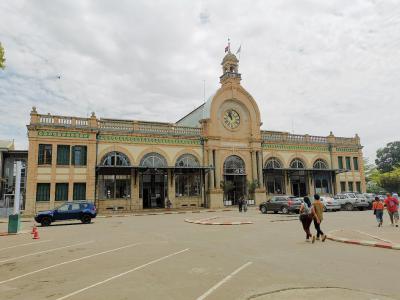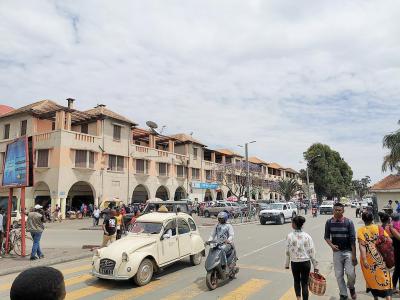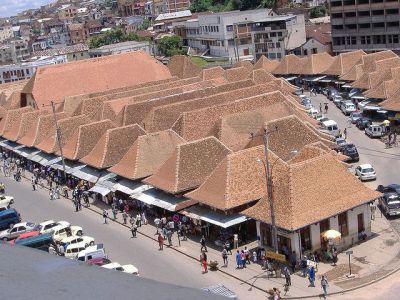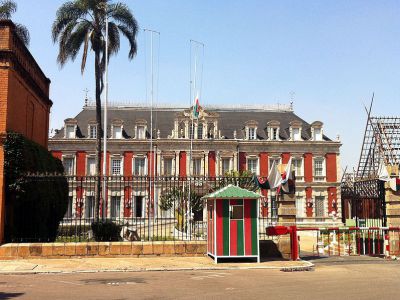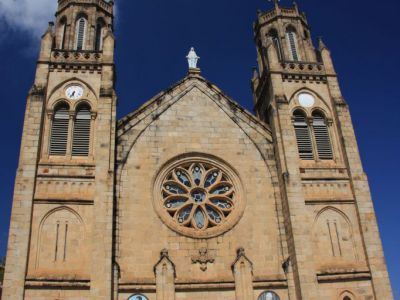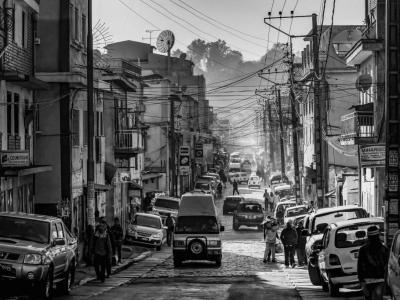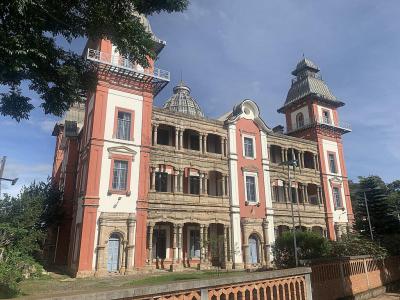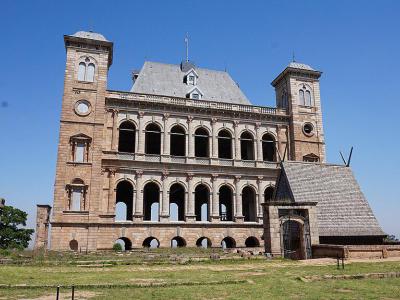Antananarivo Introduction Walking Tour (Self Guided), Antananarivo
The capital of Madagascar, Antananarivo, affectionately known by locals as Tana, is the most attractive and visited destination in the country.
Antananarivo was historically the capital of the Merina people, who continue to form the majority of the local population made up of eighteen Malagasy ethnic groups and residents of Chinese, Indian, European, and other origins.
The city was founded circa 1610 by the Merina King Andrianjaka. Declaring it the site of his capital, Andrianjaka built a fortified dwelling that eventually expanded to become the royal palace. The city retained the name Analamanga until the reign of King Andriamasinavalona at the turn of the 18th century, who renamed it Antananarivo ("City of the Thousand") in honor of Andrianjaka's soldiers.
The city served as the capital of the Kingdom of Imerina until 1710 when it was split into four warring quadrants. Antananarivo became the capital of the southern quadrant until 1794 when King Andrianampoinimerina of Ambohimanga restored it as the capital of a united Kingdom of Imerina. Antananarivo also remained the island's capital after Madagascar was colonized by the French in 1897 and after the country's independence in 1960.
The array of uncommon attractions found here holds one's interest and ensures a one-of-a-kind vacation experience for all. The city's geographical location and culture contribute to an abundance of beautiful things to see.
One of the local landmarks, the Antananarivo Railway Station, is a hub for transportation and commerce and a historic gem of colonial architecture, blending nostalgia with modern convenience.
Starting at its doorstep, Independence Avenue (Avenue de l'Independence) embodies the nation's journey to freedom, lined with historic buildings and bustling shops.
To make the most of your visit, explore the vibrant Analakely Market, Antananarivo's largest marketplace, pulsating with commercial activity and fostering social interaction.
Not far away from the market is the Ambohitsorohitra Palace, once the seat of royal power and now the official residence of the President of Madagascar.
As you explore the streets of Antananarivo, you'll discover a city brimming with charm, culture, and warmth. Take the opportunity to delve deeper into Madagascar's rich tapestry of traditions and history and embark on this self-guided tour to uncover the most enticing landmarks of its capital!
Antananarivo was historically the capital of the Merina people, who continue to form the majority of the local population made up of eighteen Malagasy ethnic groups and residents of Chinese, Indian, European, and other origins.
The city was founded circa 1610 by the Merina King Andrianjaka. Declaring it the site of his capital, Andrianjaka built a fortified dwelling that eventually expanded to become the royal palace. The city retained the name Analamanga until the reign of King Andriamasinavalona at the turn of the 18th century, who renamed it Antananarivo ("City of the Thousand") in honor of Andrianjaka's soldiers.
The city served as the capital of the Kingdom of Imerina until 1710 when it was split into four warring quadrants. Antananarivo became the capital of the southern quadrant until 1794 when King Andrianampoinimerina of Ambohimanga restored it as the capital of a united Kingdom of Imerina. Antananarivo also remained the island's capital after Madagascar was colonized by the French in 1897 and after the country's independence in 1960.
The array of uncommon attractions found here holds one's interest and ensures a one-of-a-kind vacation experience for all. The city's geographical location and culture contribute to an abundance of beautiful things to see.
One of the local landmarks, the Antananarivo Railway Station, is a hub for transportation and commerce and a historic gem of colonial architecture, blending nostalgia with modern convenience.
Starting at its doorstep, Independence Avenue (Avenue de l'Independence) embodies the nation's journey to freedom, lined with historic buildings and bustling shops.
To make the most of your visit, explore the vibrant Analakely Market, Antananarivo's largest marketplace, pulsating with commercial activity and fostering social interaction.
Not far away from the market is the Ambohitsorohitra Palace, once the seat of royal power and now the official residence of the President of Madagascar.
As you explore the streets of Antananarivo, you'll discover a city brimming with charm, culture, and warmth. Take the opportunity to delve deeper into Madagascar's rich tapestry of traditions and history and embark on this self-guided tour to uncover the most enticing landmarks of its capital!
How it works: Download the app "GPSmyCity: Walks in 1K+ Cities" from Apple App Store or Google Play Store to your mobile phone or tablet. The app turns your mobile device into a personal tour guide and its built-in GPS navigation functions guide you from one tour stop to next. The app works offline, so no data plan is needed when traveling abroad.
Antananarivo Introduction Walking Tour Map
Guide Name: Antananarivo Introduction Walking Tour
Guide Location: Madagascar » Antananarivo (See other walking tours in Antananarivo)
Guide Type: Self-guided Walking Tour (Sightseeing)
# of Attractions: 8
Tour Duration: 2 Hour(s)
Travel Distance: 3.9 Km or 2.4 Miles
Author: Dee
Sight(s) Featured in This Guide:
Guide Location: Madagascar » Antananarivo (See other walking tours in Antananarivo)
Guide Type: Self-guided Walking Tour (Sightseeing)
# of Attractions: 8
Tour Duration: 2 Hour(s)
Travel Distance: 3.9 Km or 2.4 Miles
Author: Dee
Sight(s) Featured in This Guide:
- Antananarivo Railway Station
- Avenue de l'Independence (Independence Avenue)
- Analakely Market
- Ambohitsorohitra Palace
- Roman Catholic Archdiocese of Antananarivo
- Madagascar Photography Museum
- The Andafiavaratra Museum
- Rova of Antananarivo (Queen's Palace)
1) Antananarivo Railway Station (must see)
The Antananarivo Railway Station stands as a historic landmark in Madagascar, embodying the colonial architecture of the 19th century. Despite periods of neglect, the station underwent a significant restoration effort in 2008 to preserve its cultural and architectural heritage. Today, the restored building retains its original charm while offering modern amenities to visitors and travelers.
Upon entering the station, visitors are greeted by a blend of nostalgia and functionality. Inside, there are boutiques offering various goods, providing convenience to travelers and locals alike. Additionally, a tourist office assists visitors with information and guidance, enhancing the station's role as a gateway to the city and its surroundings.
Outside the station, the Café de la Gare beckons with its inviting ambiance, reminiscent of a bygone era when people would gather to pass the time while awaiting trains. Surrounding the station's parking area, other boutiques offer opportunities for shopping, including the chance to purchase precious stones from local merchants, adding a touch of local flavor to the station experience.
Upon entering the station, visitors are greeted by a blend of nostalgia and functionality. Inside, there are boutiques offering various goods, providing convenience to travelers and locals alike. Additionally, a tourist office assists visitors with information and guidance, enhancing the station's role as a gateway to the city and its surroundings.
Outside the station, the Café de la Gare beckons with its inviting ambiance, reminiscent of a bygone era when people would gather to pass the time while awaiting trains. Surrounding the station's parking area, other boutiques offer opportunities for shopping, including the chance to purchase precious stones from local merchants, adding a touch of local flavor to the station experience.
2) Avenue de l'Independence (Independence Avenue) (must see)
Independence Avenue is a historical thoroughfare nestled in the heart of Analakely, the bustling 1st district of Antananarivo. This iconic street, previously named Avenue Fallières, bears witness to a bygone colonial era, its very essence intertwined with the intricate tapestry of Madagascar's rich history.
As one strolls along Independence Avenue, it is impossible not to be captivated by its charming features. The street boasts a timeless allure, adorned with graceful arcaded buildings and meticulously manicured flower beds graced by the presence of elegant white latan trees. This enchanting tableau serves as a testament to the meticulous urban planning and architectural aesthetics of the past.
A significant revitalization effort in 1990 breathed new life into Independence Avenue, restoring it to its former glory. The avenue stretches from the Soarano station to the bustling Analakely market, passing alongside the majestic town hall. Along its length, it hosts a vibrant mosaic of small businesses, offering a diverse array of goods and services, from sambos and single cigarettes to an array of counterfeit and pirated products.
One cannot traverse this historic avenue without encountering the intriguing Analakely stairs, which provide access to the upper town. As you ascend these steps, you are greeted by a lively atmosphere, complete with street vendors peddling their wares and engaging with passersby.
The bottom of the stairs serves as a gateway to the remnants of Zoma, known as "Friday" in Malagasy, an expansive open-air market that thrived along Independence Avenue until 1997. These days, the brick pavilions of Analakely stand as silent witnesses to the once-vibrant marketplace, a relic from the days of King Andrianampoinimerina's reign, later expanded in the 1920s.
As one strolls along Independence Avenue, it is impossible not to be captivated by its charming features. The street boasts a timeless allure, adorned with graceful arcaded buildings and meticulously manicured flower beds graced by the presence of elegant white latan trees. This enchanting tableau serves as a testament to the meticulous urban planning and architectural aesthetics of the past.
A significant revitalization effort in 1990 breathed new life into Independence Avenue, restoring it to its former glory. The avenue stretches from the Soarano station to the bustling Analakely market, passing alongside the majestic town hall. Along its length, it hosts a vibrant mosaic of small businesses, offering a diverse array of goods and services, from sambos and single cigarettes to an array of counterfeit and pirated products.
One cannot traverse this historic avenue without encountering the intriguing Analakely stairs, which provide access to the upper town. As you ascend these steps, you are greeted by a lively atmosphere, complete with street vendors peddling their wares and engaging with passersby.
The bottom of the stairs serves as a gateway to the remnants of Zoma, known as "Friday" in Malagasy, an expansive open-air market that thrived along Independence Avenue until 1997. These days, the brick pavilions of Analakely stand as silent witnesses to the once-vibrant marketplace, a relic from the days of King Andrianampoinimerina's reign, later expanded in the 1920s.
3) Analakely Market (must see)
The Analakely Market, also referred to as the Zoma Market, stands as the largest market in Antananarivo. Its pavilions bustle with activity, drawing crowds of locals and visitors alike seeking a wide array of goods essential for daily life. The market's popularity stems from its comprehensive offerings, which span from clothing to fresh produce, fish, and meat. Visitors to the market are greeted by a vibrant atmosphere filled with the sights, sounds, and aromas of commerce and culinary delights.
One of the market's distinguishing features is its diverse selection of products, catering to a wide range of tastes and preferences. From traditional Malagasy clothing and handicrafts to imported goods and exotic delicacies, the Analakely Market truly offers something for everyone. Among its eclectic offerings are unique culinary treats not commonly found in European kitchens, such as grilled lizards, showcasing Madagascar's rich culinary heritage and cultural diversity.
In addition to its role as a marketplace, the Analakely Market serves as a vibrant hub of social interaction and cultural exchange. Locals gather here not only to shop for necessities but also to connect with friends and neighbors, making it a vital community space.
One of the market's distinguishing features is its diverse selection of products, catering to a wide range of tastes and preferences. From traditional Malagasy clothing and handicrafts to imported goods and exotic delicacies, the Analakely Market truly offers something for everyone. Among its eclectic offerings are unique culinary treats not commonly found in European kitchens, such as grilled lizards, showcasing Madagascar's rich culinary heritage and cultural diversity.
In addition to its role as a marketplace, the Analakely Market serves as a vibrant hub of social interaction and cultural exchange. Locals gather here not only to shop for necessities but also to connect with friends and neighbors, making it a vital community space.
4) Ambohitsorohitra Palace
Ambohitsorohitra Palace, also known as the Presidential Palace, stands as a significant landmark in the heart of Antananarivo. Serving as the official office of the President of Madagascar, the palace holds immense political importance and is a symbol of executive power in the country. Guarded by soldiers, the palace's grounds are strictly off-limits to the public, emphasizing its role as a center of governance and administration.
Constructed between 1890 and 1892 in the rococo style, Ambohitsorohitra Palace boasts a rich architectural heritage. Designed by architect Jully, the palace was initially built as the residence of French General Bompard before serving various governmental functions over the years. From 1960 to 1976, the French Embassy occupied the palace, and from 1976 to 1989, it served as the official residence of President Didier Ratsiraka. Subsequently, the palace was repurposed as the City Hall, accommodating the mayor's office until it was reclaimed as the presidential office by President Marc Ravalomanana.
Since March 2009, Ambohitsorohitra Palace has once again become the official office of the President of Madagascar, currently held by President Andry Rajoelina. As a seat of political power and governance, the palace plays a crucial role in shaping the country's direction and policies.
Constructed between 1890 and 1892 in the rococo style, Ambohitsorohitra Palace boasts a rich architectural heritage. Designed by architect Jully, the palace was initially built as the residence of French General Bompard before serving various governmental functions over the years. From 1960 to 1976, the French Embassy occupied the palace, and from 1976 to 1989, it served as the official residence of President Didier Ratsiraka. Subsequently, the palace was repurposed as the City Hall, accommodating the mayor's office until it was reclaimed as the presidential office by President Marc Ravalomanana.
Since March 2009, Ambohitsorohitra Palace has once again become the official office of the President of Madagascar, currently held by President Andry Rajoelina. As a seat of political power and governance, the palace plays a crucial role in shaping the country's direction and policies.
5) Roman Catholic Archdiocese of Antananarivo
The Roman Catholic Archdiocese of Antananarivo, established in 1841, stands as a prominent religious institution in the capital city of Madagascar. The archdiocese encompasses a rich history and architectural heritage, with its cathedral serving as a focal point of Catholic worship in the region. Built in the Gothic style, the cathedral features a magnificent façade adorned with intricate details, including stained-glass rosette windows and gabled bell towers, reflecting the grandeur of medieval European architecture.
Upon entering the cathedral, visitors are greeted by a sanctuary characterized by ornate decorations and painted walls, evoking a sense of reverence and spiritual awe. The interior design showcases the craftsmanship of artisans who adorned the walls with intricate patterns and motifs, while the stained glass windows bathe the space in vibrant hues of light, creating a serene atmosphere conducive to prayer and contemplation. The ceiling, adorned with hardwood painted in shades of blue reminiscent of the azure skies, adds to the cathedral's celestial ambiance.
Outside the cathedral, visitors can find a grotto dedicated to the Lady of Lourdes, a revered Marian apparition in Catholic tradition. This outdoor shrine provides a space for pilgrims and devotees to offer prayers and seek spiritual solace, further enhancing the sacredness of the cathedral grounds.
Upon entering the cathedral, visitors are greeted by a sanctuary characterized by ornate decorations and painted walls, evoking a sense of reverence and spiritual awe. The interior design showcases the craftsmanship of artisans who adorned the walls with intricate patterns and motifs, while the stained glass windows bathe the space in vibrant hues of light, creating a serene atmosphere conducive to prayer and contemplation. The ceiling, adorned with hardwood painted in shades of blue reminiscent of the azure skies, adds to the cathedral's celestial ambiance.
Outside the cathedral, visitors can find a grotto dedicated to the Lady of Lourdes, a revered Marian apparition in Catholic tradition. This outdoor shrine provides a space for pilgrims and devotees to offer prayers and seek spiritual solace, further enhancing the sacredness of the cathedral grounds.
6) Madagascar Photography Museum
The Madagascar Photography Museum was established in 2013 under the auspices of association law. This unique institution has embarked on a remarkable journey to preserve and celebrate Madagascar's rich photographic heritage, dating back to the late 19th century. What began as a virtual endeavor has since blossomed into a physical sanctuary for those who seek to uncover the layers of history woven through the lens of talented Malagasy photographers.
The Madagascar Photography Museum unfolds a narrative spanning a century, from 1860 to 1960, through a captivating display of digitized photographs. Its mission extends far beyond the preservation of fragile images; it seeks to empower the Malagasy people by reconnecting them with their own history, giving them the keys to their past. Spearheaded by Professor Emeritus Malanjaona Rakotomalala, amid a landscape where public authorities exhibit limited concern for heritage, this private cultural institution emerges as a beacon of cultural stewardship.
The physical space of the museum, established in February 2018 within the former mayors' residence, offers visitors a profound exploration of Malagasy history through various mediums. Four projection rooms breathe life into these timeless images, transforming them into evocative films available in six languages. These cinematic experiences delve into thematic narratives, showcasing the great figures of 19th-century Antananarivo, the golden age of 1930s photography in Madagascar, and the historical tapestry of its main cities.
Not confined to the past, the Madagascar Photography Museum also provides a platform for contemporary photographers, both Malagasy and international, whose works offer unique perspectives on modern Madagascar. An inviting café beckons visitors to savor both culture and refreshment.
The Madagascar Photography Museum unfolds a narrative spanning a century, from 1860 to 1960, through a captivating display of digitized photographs. Its mission extends far beyond the preservation of fragile images; it seeks to empower the Malagasy people by reconnecting them with their own history, giving them the keys to their past. Spearheaded by Professor Emeritus Malanjaona Rakotomalala, amid a landscape where public authorities exhibit limited concern for heritage, this private cultural institution emerges as a beacon of cultural stewardship.
The physical space of the museum, established in February 2018 within the former mayors' residence, offers visitors a profound exploration of Malagasy history through various mediums. Four projection rooms breathe life into these timeless images, transforming them into evocative films available in six languages. These cinematic experiences delve into thematic narratives, showcasing the great figures of 19th-century Antananarivo, the golden age of 1930s photography in Madagascar, and the historical tapestry of its main cities.
Not confined to the past, the Madagascar Photography Museum also provides a platform for contemporary photographers, both Malagasy and international, whose works offer unique perspectives on modern Madagascar. An inviting café beckons visitors to savor both culture and refreshment.
7) The Andafiavaratra Museum
The Andafiavaratra Museum stands as a prominent heritage complex situated atop the Haut-Ville neighborhood in Antananarivo. Originally the residence of Prime Minister Rainilaiarivony, the palace showcases an exquisite blend of architectural elegance and historical significance. Rainilaiarivony's strategic alliances, including his marriages to three successive queens, afforded him considerable influence over the country's affairs during his tenure. The palace itself is a striking pink structure constructed in the opulent Baroque style, reflecting the grandeur and sophistication of Madagascar's royal history.
Visitors to the Andafiavaratra Museum are treated to a fascinating journey through Madagascar's storied past, with exhibits that offer insight into the lives of Prime Minister Rainilaiarivony and the queens he married, including Queen Ranavalona and Queen Victoria. The museum's collection features an array of artifacts, including furniture, portraits, and personal belongings of the royal family, meticulously preserved for posterity. Descriptions of the exhibits are provided in both English and French, ensuring accessibility for international visitors keen to delve into Madagascar's rich cultural heritage.
Among the museum's most notable attractions are the immense throne, crown, jewels, and other valuable objects and clothing belonging to Madagascar's royal lineage. These artifacts offer a glimpse into the opulent lifestyle and regal traditions that characterized the country's monarchy.
Visitors to the Andafiavaratra Museum are treated to a fascinating journey through Madagascar's storied past, with exhibits that offer insight into the lives of Prime Minister Rainilaiarivony and the queens he married, including Queen Ranavalona and Queen Victoria. The museum's collection features an array of artifacts, including furniture, portraits, and personal belongings of the royal family, meticulously preserved for posterity. Descriptions of the exhibits are provided in both English and French, ensuring accessibility for international visitors keen to delve into Madagascar's rich cultural heritage.
Among the museum's most notable attractions are the immense throne, crown, jewels, and other valuable objects and clothing belonging to Madagascar's royal lineage. These artifacts offer a glimpse into the opulent lifestyle and regal traditions that characterized the country's monarchy.
8) Rova of Antananarivo (Queen's Palace) (must see)
The genesis of the Queen's Palace can be traced back to the mid-19th century when it was envisioned by Queen Ranavalona I and meticulously designed by the Scottish missionary, James Cameron. Its initial incarnation took the form of a wooden palace, a testament to the harmonious fusion of indigenous craftsmanship and foreign influences under Cameron's expert guidance. The structural marvel of this palace was underscored by a colossal rosewood pillar, an engineering feat that stands as a testament to the era's ingenuity. This awe-inspiring pillar, stretching an astonishing 39 meters, was the result of the tireless toil of an estimated 10,000 individuals who transported this precious timber from the distant east coast.
The Queen's Palace, resplendent in its regal grandeur, boasted a luminous white facade adorned with balustrades painted in vibrant red and black, radiating an aura of majesty and opulence. The palace underwent a transformative evolution around 1870 under the stewardship of James Cameron, a name synonymous with its enduring legacy. Cameron introduced four Italian-style corner towers, timeless in their elegance, enhancing not only the palace's aesthetic allure but also its architectural uniqueness.
Nevertheless, the annals of history have not been without trials for the Queen's Palace. A devastating fire in 1995 laid waste to the palace's interior, leaving behind an indomitable legacy of ongoing restoration efforts. Despite this unfortunate setback, the palace's compound remains accessible to visitors, inviting them to delve into the opulent history of Madagascar's monarchy.
At the entrance to this historic enclave, a gate stands adorned with a carved eagle symbolizing military prowess and a phallus emblematic of circumcision and nobility. The palace's compound bears witness to the ambitions of successive rulers who erected and sometimes demolished various palatial structures on the premises, leaving scattered ruins as silent testaments to their legacies.
The Queen's Palace, resplendent in its regal grandeur, boasted a luminous white facade adorned with balustrades painted in vibrant red and black, radiating an aura of majesty and opulence. The palace underwent a transformative evolution around 1870 under the stewardship of James Cameron, a name synonymous with its enduring legacy. Cameron introduced four Italian-style corner towers, timeless in their elegance, enhancing not only the palace's aesthetic allure but also its architectural uniqueness.
Nevertheless, the annals of history have not been without trials for the Queen's Palace. A devastating fire in 1995 laid waste to the palace's interior, leaving behind an indomitable legacy of ongoing restoration efforts. Despite this unfortunate setback, the palace's compound remains accessible to visitors, inviting them to delve into the opulent history of Madagascar's monarchy.
At the entrance to this historic enclave, a gate stands adorned with a carved eagle symbolizing military prowess and a phallus emblematic of circumcision and nobility. The palace's compound bears witness to the ambitions of successive rulers who erected and sometimes demolished various palatial structures on the premises, leaving scattered ruins as silent testaments to their legacies.
The Most Popular Cities
/ view all



